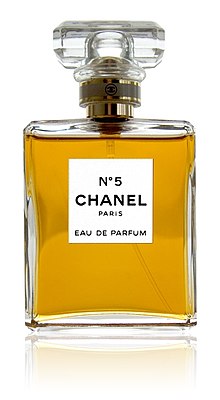Chanel No. 5
| No. 5 | |
|---|---|

Bottle of Chanel No. 5, Eau de Parfum version
|
|
| Fragrance by Coco Chanel | |
| Type | Floral-aldehydic feminine fine fragrance |
| Released | 5 May 1921, to select clientele in Chanel rue Cambon boutique |
| Label | Chanel |
Chanel No. 5 is the first perfume launched by French couturier Gabrielle "Coco" Chanel. The chemical formula for the fragrance was compounded by French-Russian chemist and perfumer Ernest Beaux.
Traditionally, fragrance worn by women had adhered to two basic categories: respectable women favored the pure essence of a single garden flower, and sexually provocative perfumes heavy with animal musk or jasmine were associated with women of the demi-monde, prostitutes or courtesans. Chanel felt the time was right for the debut of a scent that would epitomize the flapper and would speak to the liberated spirit of the 1920s.
At the age of twelve, Chanel was handed over to the care of nuns, and for the next six years spent a stark, disciplined existence in a convent orphanage, Aubazine, founded by Cistercians in the 12th century. From her earliest days there, the number five had potent associations for her. For Chanel, the number five was especially esteemed as signifying the pure embodiment of a thing, its spirit, its mystic meaning. The paths that led Chanel to the cathedral for daily prayer were laid out in circular patterns repeating the number five.
Her affinity for the number five co-mingled with the abbey gardens, and by extension the lush surrounding hillsides abounding with cistus, a five-petal rose.
In 1920, when presented with small glass vials containing sample scent compositions numbered 1 to 5 and 20 to 24 for her assessment, she chose the fifth vial. Chanel told her master perfumer, Ernest Beaux, whom she had commissioned to develop a fragrance with modern innovations: "I present my dress collections on the fifth of May, the fifth month of the year and so we will let this sample number five keep the name it has already, it will bring good luck."
Chanel envisioned a design that would be an antidote for the over-elaborate, precious fussiness of the crystal fragrance bottles then in fashion popularized by Lalique and Baccarat. Her bottle would be "pure transparency ...an invisible bottle." It is generally considered that the bottle design was inspired by the rectangular beveled lines of the Charvet toiletry bottles, which, outfitted in a leather traveling case, were favored by her lover, Arthur "Boy" Capel. Some say it was the whiskey decanter he used that she admired and wished to reproduce in "exquisite, expensive, delicate glass."
...
Wikipedia
